Procurement and Contracts
VerifiedAdded on 2023/03/23
|9
|2175
|79
AI Summary
This study material discusses the procurement and contracts involved in the construction of the New Royal Adelaide Hospital in Australia. It explores the challenges, risks, and control points in project management. The material also highlights the importance of vendor negotiation and the implications of delayed opening dates. It concludes with a discussion on risk management and change management in the project.
Contribute Materials
Your contribution can guide someone’s learning journey. Share your
documents today.
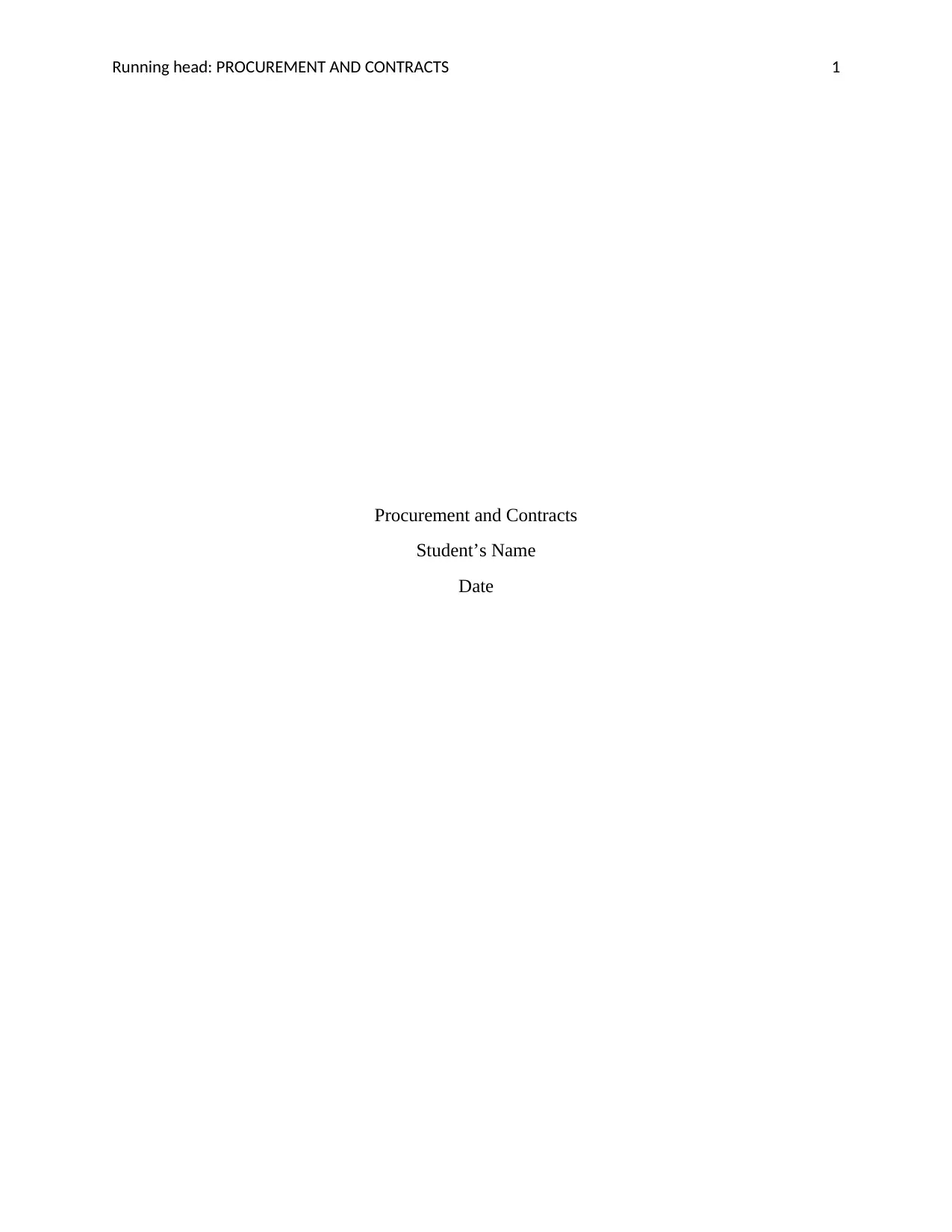
Running head: PROCUREMENT AND CONTRACTS 1
Procurement and Contracts
Student’s Name
Date
Procurement and Contracts
Student’s Name
Date
Secure Best Marks with AI Grader
Need help grading? Try our AI Grader for instant feedback on your assignments.
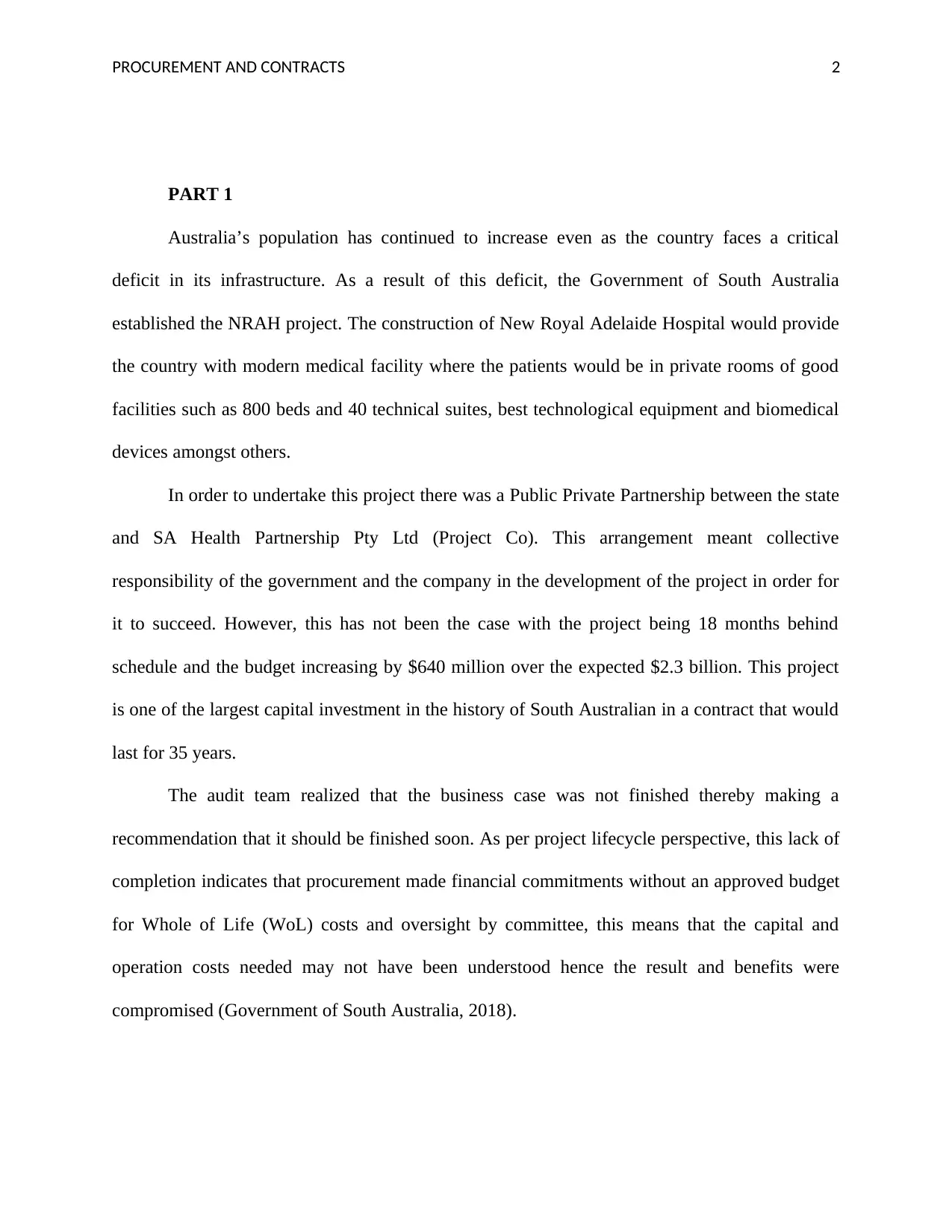
PROCUREMENT AND CONTRACTS 2
PART 1
Australia’s population has continued to increase even as the country faces a critical
deficit in its infrastructure. As a result of this deficit, the Government of South Australia
established the NRAH project. The construction of New Royal Adelaide Hospital would provide
the country with modern medical facility where the patients would be in private rooms of good
facilities such as 800 beds and 40 technical suites, best technological equipment and biomedical
devices amongst others.
In order to undertake this project there was a Public Private Partnership between the state
and SA Health Partnership Pty Ltd (Project Co). This arrangement meant collective
responsibility of the government and the company in the development of the project in order for
it to succeed. However, this has not been the case with the project being 18 months behind
schedule and the budget increasing by $640 million over the expected $2.3 billion. This project
is one of the largest capital investment in the history of South Australian in a contract that would
last for 35 years.
The audit team realized that the business case was not finished thereby making a
recommendation that it should be finished soon. As per project lifecycle perspective, this lack of
completion indicates that procurement made financial commitments without an approved budget
for Whole of Life (WoL) costs and oversight by committee, this means that the capital and
operation costs needed may not have been understood hence the result and benefits were
compromised (Government of South Australia, 2018).
PART 1
Australia’s population has continued to increase even as the country faces a critical
deficit in its infrastructure. As a result of this deficit, the Government of South Australia
established the NRAH project. The construction of New Royal Adelaide Hospital would provide
the country with modern medical facility where the patients would be in private rooms of good
facilities such as 800 beds and 40 technical suites, best technological equipment and biomedical
devices amongst others.
In order to undertake this project there was a Public Private Partnership between the state
and SA Health Partnership Pty Ltd (Project Co). This arrangement meant collective
responsibility of the government and the company in the development of the project in order for
it to succeed. However, this has not been the case with the project being 18 months behind
schedule and the budget increasing by $640 million over the expected $2.3 billion. This project
is one of the largest capital investment in the history of South Australian in a contract that would
last for 35 years.
The audit team realized that the business case was not finished thereby making a
recommendation that it should be finished soon. As per project lifecycle perspective, this lack of
completion indicates that procurement made financial commitments without an approved budget
for Whole of Life (WoL) costs and oversight by committee, this means that the capital and
operation costs needed may not have been understood hence the result and benefits were
compromised (Government of South Australia, 2018).
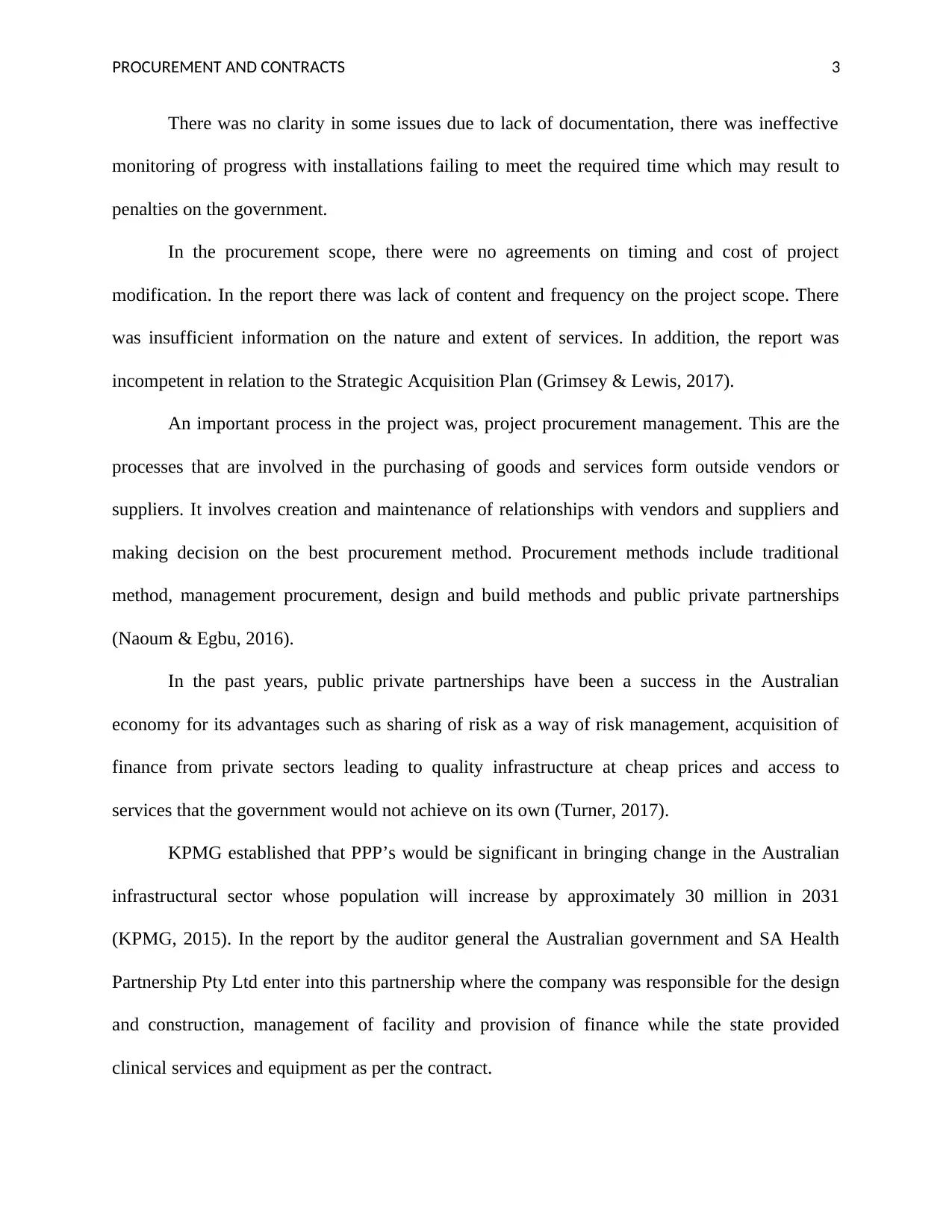
PROCUREMENT AND CONTRACTS 3
There was no clarity in some issues due to lack of documentation, there was ineffective
monitoring of progress with installations failing to meet the required time which may result to
penalties on the government.
In the procurement scope, there were no agreements on timing and cost of project
modification. In the report there was lack of content and frequency on the project scope. There
was insufficient information on the nature and extent of services. In addition, the report was
incompetent in relation to the Strategic Acquisition Plan (Grimsey & Lewis, 2017).
An important process in the project was, project procurement management. This are the
processes that are involved in the purchasing of goods and services form outside vendors or
suppliers. It involves creation and maintenance of relationships with vendors and suppliers and
making decision on the best procurement method. Procurement methods include traditional
method, management procurement, design and build methods and public private partnerships
(Naoum & Egbu, 2016).
In the past years, public private partnerships have been a success in the Australian
economy for its advantages such as sharing of risk as a way of risk management, acquisition of
finance from private sectors leading to quality infrastructure at cheap prices and access to
services that the government would not achieve on its own (Turner, 2017).
KPMG established that PPP’s would be significant in bringing change in the Australian
infrastructural sector whose population will increase by approximately 30 million in 2031
(KPMG, 2015). In the report by the auditor general the Australian government and SA Health
Partnership Pty Ltd enter into this partnership where the company was responsible for the design
and construction, management of facility and provision of finance while the state provided
clinical services and equipment as per the contract.
There was no clarity in some issues due to lack of documentation, there was ineffective
monitoring of progress with installations failing to meet the required time which may result to
penalties on the government.
In the procurement scope, there were no agreements on timing and cost of project
modification. In the report there was lack of content and frequency on the project scope. There
was insufficient information on the nature and extent of services. In addition, the report was
incompetent in relation to the Strategic Acquisition Plan (Grimsey & Lewis, 2017).
An important process in the project was, project procurement management. This are the
processes that are involved in the purchasing of goods and services form outside vendors or
suppliers. It involves creation and maintenance of relationships with vendors and suppliers and
making decision on the best procurement method. Procurement methods include traditional
method, management procurement, design and build methods and public private partnerships
(Naoum & Egbu, 2016).
In the past years, public private partnerships have been a success in the Australian
economy for its advantages such as sharing of risk as a way of risk management, acquisition of
finance from private sectors leading to quality infrastructure at cheap prices and access to
services that the government would not achieve on its own (Turner, 2017).
KPMG established that PPP’s would be significant in bringing change in the Australian
infrastructural sector whose population will increase by approximately 30 million in 2031
(KPMG, 2015). In the report by the auditor general the Australian government and SA Health
Partnership Pty Ltd enter into this partnership where the company was responsible for the design
and construction, management of facility and provision of finance while the state provided
clinical services and equipment as per the contract.
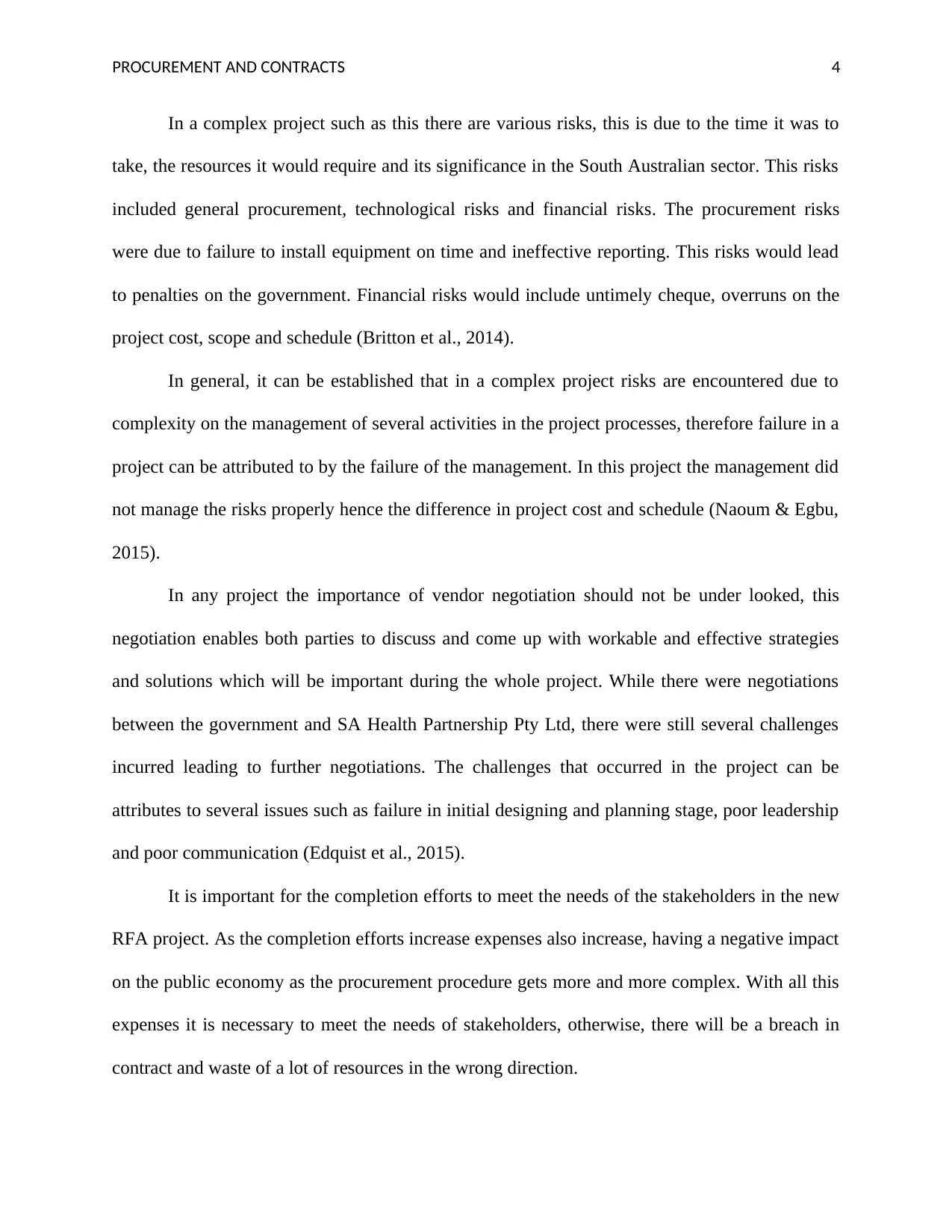
PROCUREMENT AND CONTRACTS 4
In a complex project such as this there are various risks, this is due to the time it was to
take, the resources it would require and its significance in the South Australian sector. This risks
included general procurement, technological risks and financial risks. The procurement risks
were due to failure to install equipment on time and ineffective reporting. This risks would lead
to penalties on the government. Financial risks would include untimely cheque, overruns on the
project cost, scope and schedule (Britton et al., 2014).
In general, it can be established that in a complex project risks are encountered due to
complexity on the management of several activities in the project processes, therefore failure in a
project can be attributed to by the failure of the management. In this project the management did
not manage the risks properly hence the difference in project cost and schedule (Naoum & Egbu,
2015).
In any project the importance of vendor negotiation should not be under looked, this
negotiation enables both parties to discuss and come up with workable and effective strategies
and solutions which will be important during the whole project. While there were negotiations
between the government and SA Health Partnership Pty Ltd, there were still several challenges
incurred leading to further negotiations. The challenges that occurred in the project can be
attributes to several issues such as failure in initial designing and planning stage, poor leadership
and poor communication (Edquist et al., 2015).
It is important for the completion efforts to meet the needs of the stakeholders in the new
RFA project. As the completion efforts increase expenses also increase, having a negative impact
on the public economy as the procurement procedure gets more and more complex. With all this
expenses it is necessary to meet the needs of stakeholders, otherwise, there will be a breach in
contract and waste of a lot of resources in the wrong direction.
In a complex project such as this there are various risks, this is due to the time it was to
take, the resources it would require and its significance in the South Australian sector. This risks
included general procurement, technological risks and financial risks. The procurement risks
were due to failure to install equipment on time and ineffective reporting. This risks would lead
to penalties on the government. Financial risks would include untimely cheque, overruns on the
project cost, scope and schedule (Britton et al., 2014).
In general, it can be established that in a complex project risks are encountered due to
complexity on the management of several activities in the project processes, therefore failure in a
project can be attributed to by the failure of the management. In this project the management did
not manage the risks properly hence the difference in project cost and schedule (Naoum & Egbu,
2015).
In any project the importance of vendor negotiation should not be under looked, this
negotiation enables both parties to discuss and come up with workable and effective strategies
and solutions which will be important during the whole project. While there were negotiations
between the government and SA Health Partnership Pty Ltd, there were still several challenges
incurred leading to further negotiations. The challenges that occurred in the project can be
attributes to several issues such as failure in initial designing and planning stage, poor leadership
and poor communication (Edquist et al., 2015).
It is important for the completion efforts to meet the needs of the stakeholders in the new
RFA project. As the completion efforts increase expenses also increase, having a negative impact
on the public economy as the procurement procedure gets more and more complex. With all this
expenses it is necessary to meet the needs of stakeholders, otherwise, there will be a breach in
contract and waste of a lot of resources in the wrong direction.
Secure Best Marks with AI Grader
Need help grading? Try our AI Grader for instant feedback on your assignments.
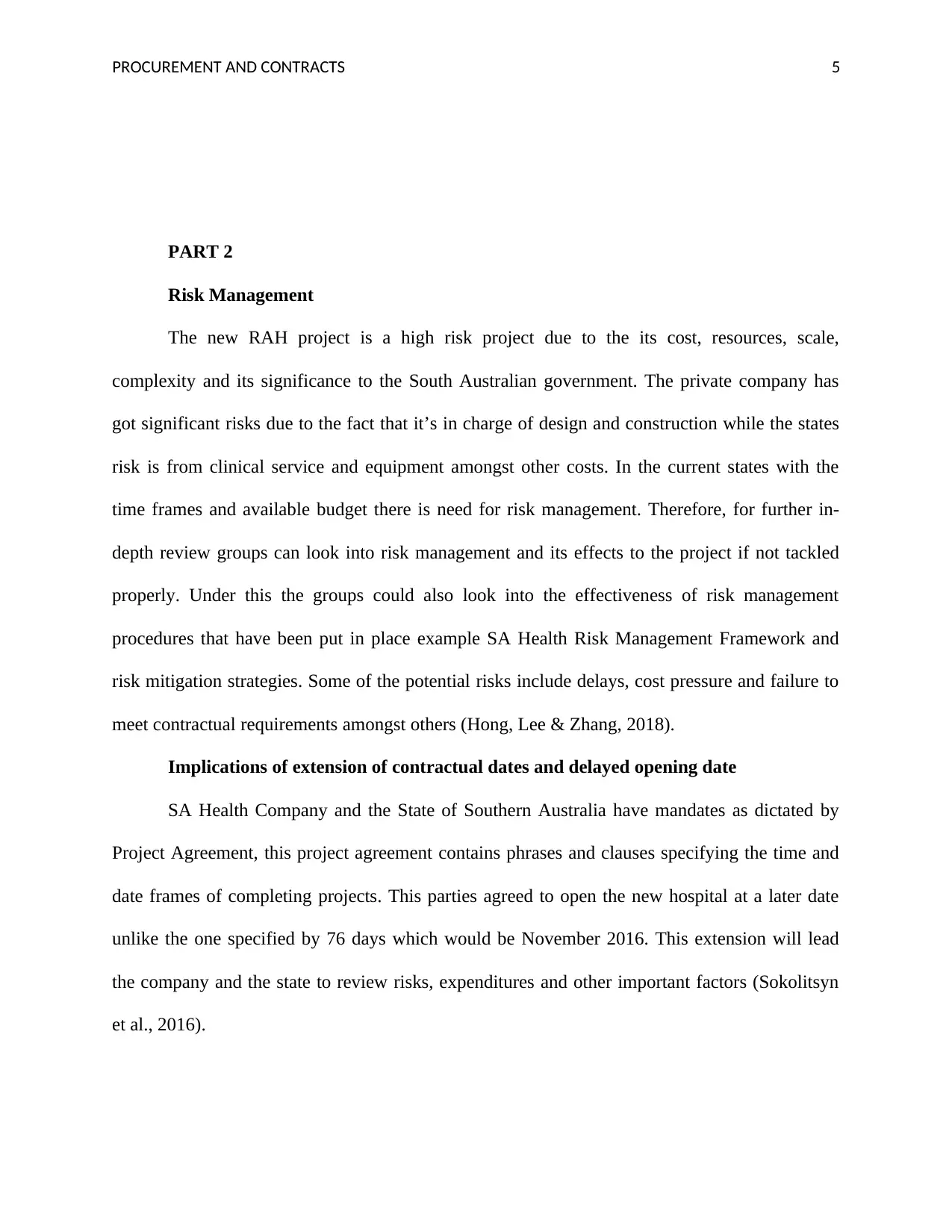
PROCUREMENT AND CONTRACTS 5
PART 2
Risk Management
The new RAH project is a high risk project due to the its cost, resources, scale,
complexity and its significance to the South Australian government. The private company has
got significant risks due to the fact that it’s in charge of design and construction while the states
risk is from clinical service and equipment amongst other costs. In the current states with the
time frames and available budget there is need for risk management. Therefore, for further in-
depth review groups can look into risk management and its effects to the project if not tackled
properly. Under this the groups could also look into the effectiveness of risk management
procedures that have been put in place example SA Health Risk Management Framework and
risk mitigation strategies. Some of the potential risks include delays, cost pressure and failure to
meet contractual requirements amongst others (Hong, Lee & Zhang, 2018).
Implications of extension of contractual dates and delayed opening date
SA Health Company and the State of Southern Australia have mandates as dictated by
Project Agreement, this project agreement contains phrases and clauses specifying the time and
date frames of completing projects. This parties agreed to open the new hospital at a later date
unlike the one specified by 76 days which would be November 2016. This extension will lead
the company and the state to review risks, expenditures and other important factors (Sokolitsyn
et al., 2016).
PART 2
Risk Management
The new RAH project is a high risk project due to the its cost, resources, scale,
complexity and its significance to the South Australian government. The private company has
got significant risks due to the fact that it’s in charge of design and construction while the states
risk is from clinical service and equipment amongst other costs. In the current states with the
time frames and available budget there is need for risk management. Therefore, for further in-
depth review groups can look into risk management and its effects to the project if not tackled
properly. Under this the groups could also look into the effectiveness of risk management
procedures that have been put in place example SA Health Risk Management Framework and
risk mitigation strategies. Some of the potential risks include delays, cost pressure and failure to
meet contractual requirements amongst others (Hong, Lee & Zhang, 2018).
Implications of extension of contractual dates and delayed opening date
SA Health Company and the State of Southern Australia have mandates as dictated by
Project Agreement, this project agreement contains phrases and clauses specifying the time and
date frames of completing projects. This parties agreed to open the new hospital at a later date
unlike the one specified by 76 days which would be November 2016. This extension will lead
the company and the state to review risks, expenditures and other important factors (Sokolitsyn
et al., 2016).
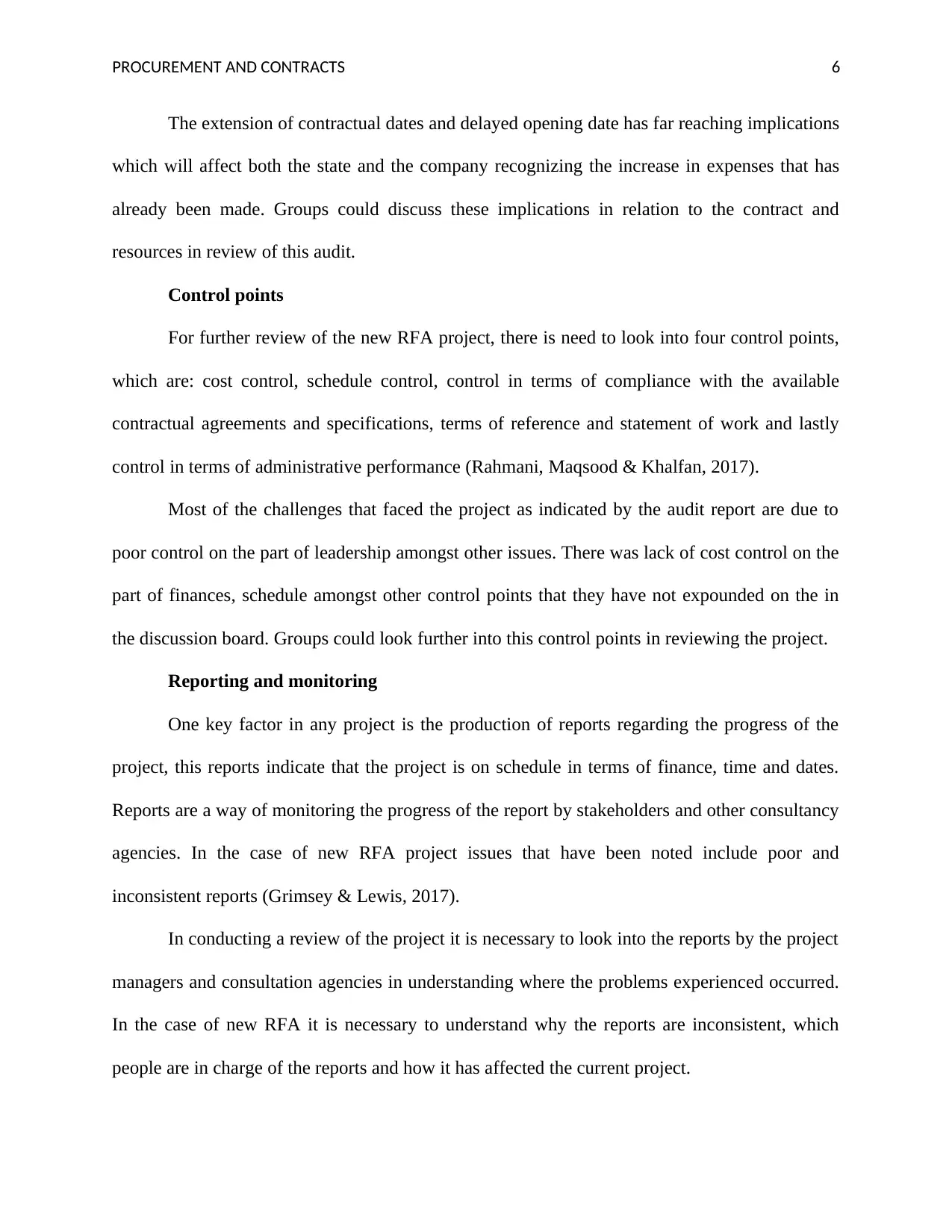
PROCUREMENT AND CONTRACTS 6
The extension of contractual dates and delayed opening date has far reaching implications
which will affect both the state and the company recognizing the increase in expenses that has
already been made. Groups could discuss these implications in relation to the contract and
resources in review of this audit.
Control points
For further review of the new RFA project, there is need to look into four control points,
which are: cost control, schedule control, control in terms of compliance with the available
contractual agreements and specifications, terms of reference and statement of work and lastly
control in terms of administrative performance (Rahmani, Maqsood & Khalfan, 2017).
Most of the challenges that faced the project as indicated by the audit report are due to
poor control on the part of leadership amongst other issues. There was lack of cost control on the
part of finances, schedule amongst other control points that they have not expounded on the in
the discussion board. Groups could look further into this control points in reviewing the project.
Reporting and monitoring
One key factor in any project is the production of reports regarding the progress of the
project, this reports indicate that the project is on schedule in terms of finance, time and dates.
Reports are a way of monitoring the progress of the report by stakeholders and other consultancy
agencies. In the case of new RFA project issues that have been noted include poor and
inconsistent reports (Grimsey & Lewis, 2017).
In conducting a review of the project it is necessary to look into the reports by the project
managers and consultation agencies in understanding where the problems experienced occurred.
In the case of new RFA it is necessary to understand why the reports are inconsistent, which
people are in charge of the reports and how it has affected the current project.
The extension of contractual dates and delayed opening date has far reaching implications
which will affect both the state and the company recognizing the increase in expenses that has
already been made. Groups could discuss these implications in relation to the contract and
resources in review of this audit.
Control points
For further review of the new RFA project, there is need to look into four control points,
which are: cost control, schedule control, control in terms of compliance with the available
contractual agreements and specifications, terms of reference and statement of work and lastly
control in terms of administrative performance (Rahmani, Maqsood & Khalfan, 2017).
Most of the challenges that faced the project as indicated by the audit report are due to
poor control on the part of leadership amongst other issues. There was lack of cost control on the
part of finances, schedule amongst other control points that they have not expounded on the in
the discussion board. Groups could look further into this control points in reviewing the project.
Reporting and monitoring
One key factor in any project is the production of reports regarding the progress of the
project, this reports indicate that the project is on schedule in terms of finance, time and dates.
Reports are a way of monitoring the progress of the report by stakeholders and other consultancy
agencies. In the case of new RFA project issues that have been noted include poor and
inconsistent reports (Grimsey & Lewis, 2017).
In conducting a review of the project it is necessary to look into the reports by the project
managers and consultation agencies in understanding where the problems experienced occurred.
In the case of new RFA it is necessary to understand why the reports are inconsistent, which
people are in charge of the reports and how it has affected the current project.
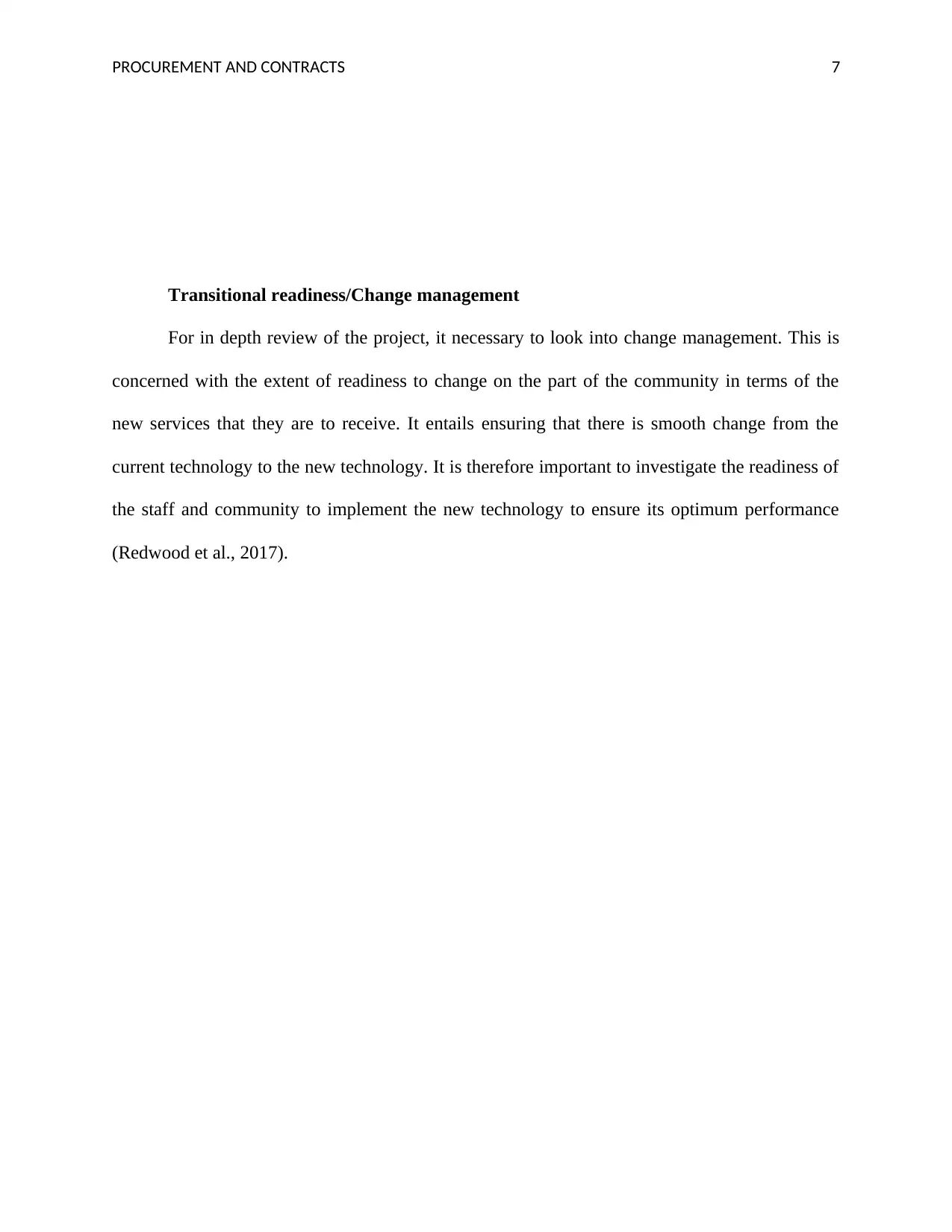
PROCUREMENT AND CONTRACTS 7
Transitional readiness/Change management
For in depth review of the project, it necessary to look into change management. This is
concerned with the extent of readiness to change on the part of the community in terms of the
new services that they are to receive. It entails ensuring that there is smooth change from the
current technology to the new technology. It is therefore important to investigate the readiness of
the staff and community to implement the new technology to ensure its optimum performance
(Redwood et al., 2017).
Transitional readiness/Change management
For in depth review of the project, it necessary to look into change management. This is
concerned with the extent of readiness to change on the part of the community in terms of the
new services that they are to receive. It entails ensuring that there is smooth change from the
current technology to the new technology. It is therefore important to investigate the readiness of
the staff and community to implement the new technology to ensure its optimum performance
(Redwood et al., 2017).
Paraphrase This Document
Need a fresh take? Get an instant paraphrase of this document with our AI Paraphraser
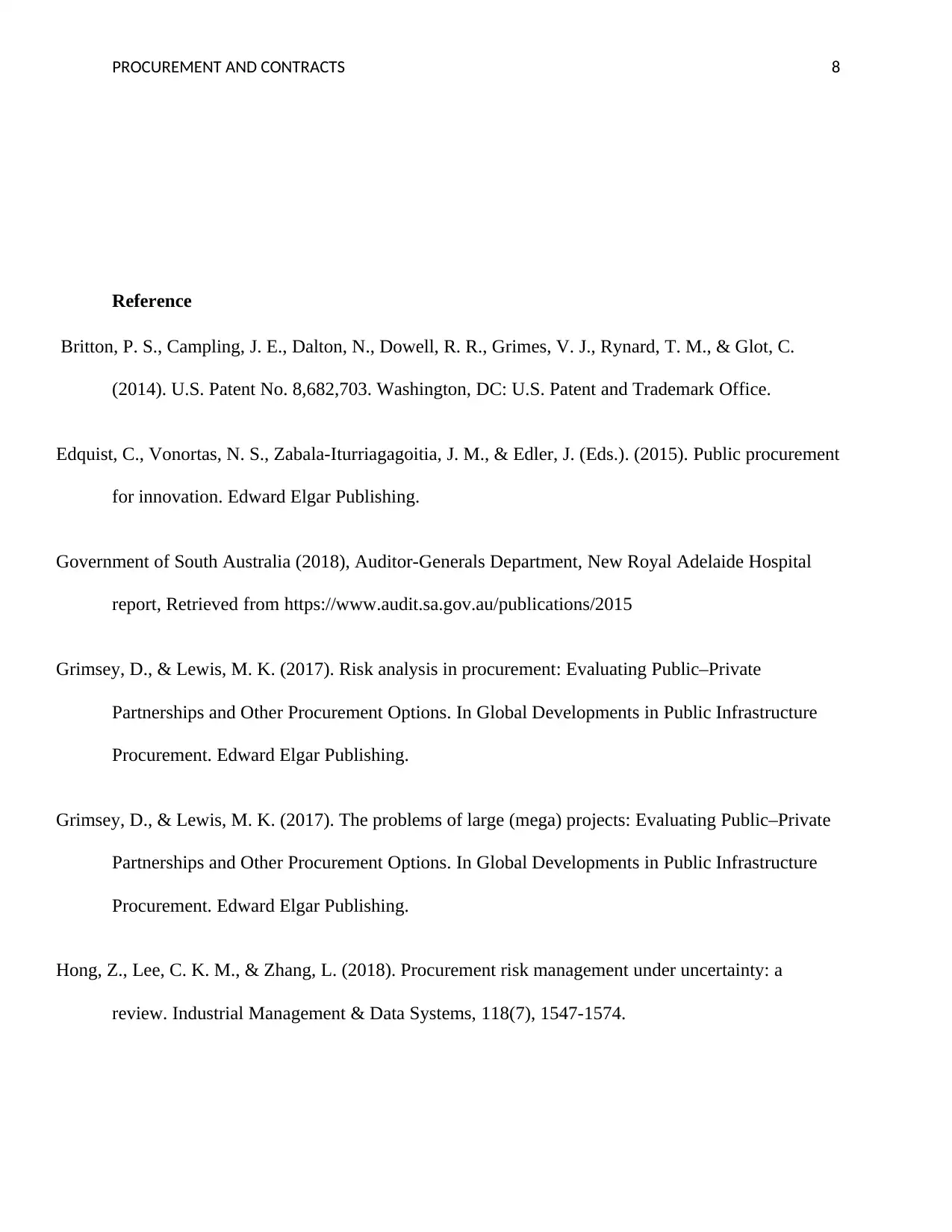
PROCUREMENT AND CONTRACTS 8
Reference
Britton, P. S., Campling, J. E., Dalton, N., Dowell, R. R., Grimes, V. J., Rynard, T. M., & Glot, C.
(2014). U.S. Patent No. 8,682,703. Washington, DC: U.S. Patent and Trademark Office.
Edquist, C., Vonortas, N. S., Zabala-Iturriagagoitia, J. M., & Edler, J. (Eds.). (2015). Public procurement
for innovation. Edward Elgar Publishing.
Government of South Australia (2018), Auditor-Generals Department, New Royal Adelaide Hospital
report, Retrieved from https://www.audit.sa.gov.au/publications/2015
Grimsey, D., & Lewis, M. K. (2017). Risk analysis in procurement: Evaluating Public–Private
Partnerships and Other Procurement Options. In Global Developments in Public Infrastructure
Procurement. Edward Elgar Publishing.
Grimsey, D., & Lewis, M. K. (2017). The problems of large (mega) projects: Evaluating Public–Private
Partnerships and Other Procurement Options. In Global Developments in Public Infrastructure
Procurement. Edward Elgar Publishing.
Hong, Z., Lee, C. K. M., & Zhang, L. (2018). Procurement risk management under uncertainty: a
review. Industrial Management & Data Systems, 118(7), 1547-1574.
Reference
Britton, P. S., Campling, J. E., Dalton, N., Dowell, R. R., Grimes, V. J., Rynard, T. M., & Glot, C.
(2014). U.S. Patent No. 8,682,703. Washington, DC: U.S. Patent and Trademark Office.
Edquist, C., Vonortas, N. S., Zabala-Iturriagagoitia, J. M., & Edler, J. (Eds.). (2015). Public procurement
for innovation. Edward Elgar Publishing.
Government of South Australia (2018), Auditor-Generals Department, New Royal Adelaide Hospital
report, Retrieved from https://www.audit.sa.gov.au/publications/2015
Grimsey, D., & Lewis, M. K. (2017). Risk analysis in procurement: Evaluating Public–Private
Partnerships and Other Procurement Options. In Global Developments in Public Infrastructure
Procurement. Edward Elgar Publishing.
Grimsey, D., & Lewis, M. K. (2017). The problems of large (mega) projects: Evaluating Public–Private
Partnerships and Other Procurement Options. In Global Developments in Public Infrastructure
Procurement. Edward Elgar Publishing.
Hong, Z., Lee, C. K. M., & Zhang, L. (2018). Procurement risk management under uncertainty: a
review. Industrial Management & Data Systems, 118(7), 1547-1574.
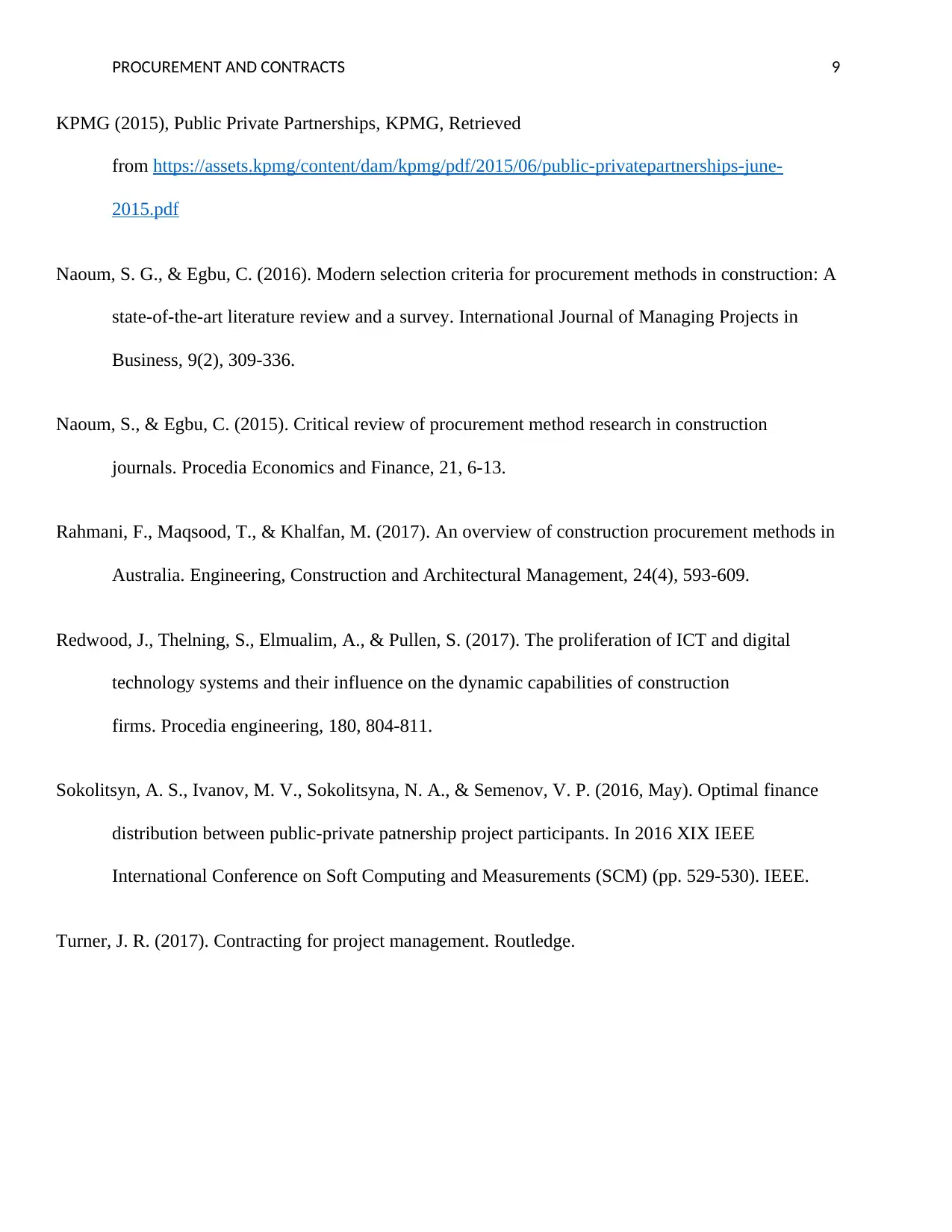
PROCUREMENT AND CONTRACTS 9
KPMG (2015), Public Private Partnerships, KPMG, Retrieved
from https://assets.kpmg/content/dam/kpmg/pdf/2015/06/public-privatepartnerships-june-
2015.pdf
Naoum, S. G., & Egbu, C. (2016). Modern selection criteria for procurement methods in construction: A
state-of-the-art literature review and a survey. International Journal of Managing Projects in
Business, 9(2), 309-336.
Naoum, S., & Egbu, C. (2015). Critical review of procurement method research in construction
journals. Procedia Economics and Finance, 21, 6-13.
Rahmani, F., Maqsood, T., & Khalfan, M. (2017). An overview of construction procurement methods in
Australia. Engineering, Construction and Architectural Management, 24(4), 593-609.
Redwood, J., Thelning, S., Elmualim, A., & Pullen, S. (2017). The proliferation of ICT and digital
technology systems and their influence on the dynamic capabilities of construction
firms. Procedia engineering, 180, 804-811.
Sokolitsyn, A. S., Ivanov, M. V., Sokolitsyna, N. A., & Semenov, V. P. (2016, May). Optimal finance
distribution between public-private patnership project participants. In 2016 XIX IEEE
International Conference on Soft Computing and Measurements (SCM) (pp. 529-530). IEEE.
Turner, J. R. (2017). Contracting for project management. Routledge.
KPMG (2015), Public Private Partnerships, KPMG, Retrieved
from https://assets.kpmg/content/dam/kpmg/pdf/2015/06/public-privatepartnerships-june-
2015.pdf
Naoum, S. G., & Egbu, C. (2016). Modern selection criteria for procurement methods in construction: A
state-of-the-art literature review and a survey. International Journal of Managing Projects in
Business, 9(2), 309-336.
Naoum, S., & Egbu, C. (2015). Critical review of procurement method research in construction
journals. Procedia Economics and Finance, 21, 6-13.
Rahmani, F., Maqsood, T., & Khalfan, M. (2017). An overview of construction procurement methods in
Australia. Engineering, Construction and Architectural Management, 24(4), 593-609.
Redwood, J., Thelning, S., Elmualim, A., & Pullen, S. (2017). The proliferation of ICT and digital
technology systems and their influence on the dynamic capabilities of construction
firms. Procedia engineering, 180, 804-811.
Sokolitsyn, A. S., Ivanov, M. V., Sokolitsyna, N. A., & Semenov, V. P. (2016, May). Optimal finance
distribution between public-private patnership project participants. In 2016 XIX IEEE
International Conference on Soft Computing and Measurements (SCM) (pp. 529-530). IEEE.
Turner, J. R. (2017). Contracting for project management. Routledge.
1 out of 9
Related Documents
Your All-in-One AI-Powered Toolkit for Academic Success.
+13062052269
info@desklib.com
Available 24*7 on WhatsApp / Email
![[object Object]](/_next/static/media/star-bottom.7253800d.svg)
Unlock your academic potential
© 2024 | Zucol Services PVT LTD | All rights reserved.





